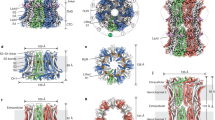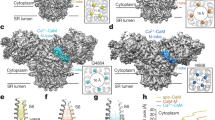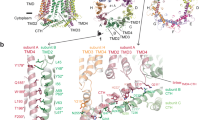Abstract
Sodium channels are principal molecular determinants responsible for myocardial conduction and maintenance of the cardiac rhythm. Calcium ions (Ca2+) have a fundamental role in the coupling of cardiac myocyte excitation and contraction, yet mechanisms whereby intracellular Ca2+ may directly modulate Na channel function have yet to be identified. Here we show that calmodulin (CaM), a ubiquitous Ca2+-sensing protein, binds to the carboxy-terminal ‘IQ’ domain1 of the human cardiac Na channel (hH1) in a Ca2+-dependent manner. This binding interaction significantly enhances slow inactivation—a channel-gating process linked to life-threatening idiopathic ventricular arrhythmias2,3. Mutations targeted to the IQ domain disrupted CaM binding and eliminated Ca2+/CaM-dependent slow inactivation, whereas the gating effects of Ca2+/CaM were restored by intracellular application of a peptide modelled after the IQ domain. A naturally occurring mutation (A1924T) in the IQ domain altered hH1 function in a manner characteristic of the Brugada arrhythmia syndrome4,5, but at the same time inhibited slow inactivation induced by Ca2+/CaM, yielding a clinically benign (arrhythmia free) phenotype.
This is a preview of subscription content, access via your institution
Access options
Subscribe to this journal
Receive 51 print issues and online access
$199.00 per year
only $3.90 per issue
Buy this article
- Purchase on Springer Link
- Instant access to full article PDF
Prices may be subject to local taxes which are calculated during checkout




Similar content being viewed by others
References
Zuhlke, R. D. & Reuter, H. Ca2+-sensitive inactivation of L-type Ca2+ channels depends on multiple cytoplasmic amino acid sequences of the alpha1C subunit. Proc. Natl Acad. Sci. USA 95, 3287–3294 (1998).
Veldkamp, M. W. et al. Two distinct congenital arrhythmias evoked by a multidysfunctional Na+ channel. Circ. Res. 86, E91–E97 (2000).
Wang, D. W., Makita, N., Kitabatake, A., Balser, J. R. & George, A. L. Enhanced sodium channel intermediate inactivation in Brugada syndrome. Circ. Res. 87, E37–E43 (2000).
Chen, Q. et al. Genetic basis and molecular mechanism for idiopathic ventricular fibrillation. Nature 392, 293–296 (1998).
Dumaine, R. et al. Ionic mechanisms responsible for the electrocardiographic phenotype of the Brugada syndrome are temperature dependent. Circ. Res. 85, 803–809 (1999).
Babu, Y. S. et al. Three-dimensional structure of calmodulin. Nature 315, 37–40 (1985).
Lee, A. et al. Ca2+/calmodulin binds to and modulates P/Q-type calcium channels. Nature 399, 155–159 (1999).
DeMaria, C. D., Soong, T. W., Alseikhan, B. A., Alvania, R. S. & Yue, D. T. Calmodulin bifurcates the local Ca2+ signal that modulates P/Q-type Ca2+ channels. Nature 411, 484–489 (2001).
Mori, M. et al. Novel interaction of the voltage-dependent sodium channel (VDSC) with calmodulin: does VDSC acquire calmodulin-mediated Ca2+-sensitivity? Biochemistry 39, 1316–1323 (2000).
Payne, M. E. et al. Calcium/calmodulin-dependent protein kinase II. Characterization of distinct calmodulin binding and inhibitory domains. J. Biol. Chem. 263, 7190–7195 (1988).
Hanley, R. M. et al. Functional analysis of a complementary DNA for the 50-kilodalton subunit of calmodulin kinase II. Science 237, 293–297 (1987).
Rudy, B. Slow inactivation of the sodium conductance in squid giant axons. Pronase resistance. J. Physiol. (Lond.) 238, 1–21 (1978).
Richmond, J. E., Featherstone, D. E., Hartmann, H. A. & Ruben, P. C. Slow inactivation in human cardiac sodium channels. Biophys. J. 74, 2945–2952 (1998).
Todt, H., Dudley, S. C. Jr, Kyle, J. W., French, R. J. & Fozzard, H. A. Ultra-slow inactivation in mu1 Na+ channels is produced by a structural rearrangement of the outer vestibule. Biophys. J. 76, 1335–1345 (1999).
Keen, J. E. et al. Domains responsible for constitutive and Ca(2+)-dependent interactions between calmodulin and small conductance Ca(2+)-activated potassium channels. J. Neurosci. 19, 8830–8838 (1999).
Xia, X. M. et al. Mechanism of calcium gating in small-conductance calcium-activated potassium channels. Nature 395, 503–507 (1998).
Rhoads, A. R. & Friedberg, F. Sequence motifs for calmodulin recognition. FASEB J. 11, 331–340 (1997).
Maune, J. F., Klee, C. B. & Beckingham, K. Ca2+ binding and conformational change in two series of point mutations to the individual Ca(2+)-binding sites of calmodulin. J. Biol. Chem. 267, 5286–5295 (1992).
Brugada, P. & Brugada, J. Right bundle branch block, persistent ST segment elevation and sudden cardiac death: a distinct clinical and electrocardiographic syndrome. A multicenter report. J. Am. Coll. Cardiol. 20, 1391–1396 (1992).
Tiso, N. et al. Identification of mutations in the cardiac ryanodine receptor gene in families affected with arrhythmogenic right ventricular cardiomyopathy type 2 (ARVD2). Hum. Mol. Genet. 10, 189–194 (2001).
Rook, M. B. et al. Human SCN5A gene mutations alter cardiac sodium channel kinetics and are associated with the Brugada syndrome. Cardiovasc. Res. 44, 507–517 (1999).
Wilde, A. A. M. & Duren, D. Sudden cardiac death, RBBB, and right precordial ST-segment elevation. Circulation 99, 722–723 (1999).
Balser, J. R. Sodium ‘channelopathies’ and sudden death: must you be so sensitive? Circ. Res. 85, 872–874 (1999).
Clusin, W. T., Buchbinder, M. & Harrison, D. C. Calcium overload, ‘injury’ current, and early ischaemic cardiac arrhythmias—a direct connection. Lancet 1, 272–274 (1983).
Di Diego, J. M. & Antzelevitch, C. High [Ca2+]o-induced electrical heterogeneity and extrasystolic activity in isolated canine ventricular epicardium. Phase 2 reentry. Circulation 89, 1839–1850 (1994).
Aimond, F., Alvarez, J. L., Rauzier, J. M., Lorente, P. & Vassort, G. Ionic basis of ventricular arrhythmias in remodeled rat heart during long-term myocardial infarction. Cardiovasc. Res. 42, 402–415 (1999).
Tan, H. L. et al. A sodium channel mutation causes isolated cardiac conduction disease. Nature 409, 1043–1047 (2001).
Bers, D. M., Patton, C. W. & Nuccitelli, R. A practical guide to the preparation of Ca2+ buffers. Methods Cell Biol. 40, 3–29 (1994).
Braun, A. P. & Schulman, H. A non-selective cation current activated via the multifunctional Ca(2+)-calmodulin-dependent protein kinase in human epithelial cells. J. Physiol. (Lond.) 488, 37–55 (1995).
James, P., Halladay, J. & Craig, E. A. Genomic libraries and a host strain designed for highly efficient two-hybrid selection in yeast. Genetics 144, 1425–1436 (1996).
Acknowledgements
We acknowledge C. R. Bezzina for genetic analysis of A1924T, C. A. Conrath for subcloning A1924T, and A. George for critique. H.L.T. was supported by a fellowship from the Royal Netherlands Academy of Arts and Sciences. Additional financial support was provided by the Interuniversity Cardiology Institute Netherlands project 27 (H.L.T. and A.A.M.W.), the Dutch Heart Foundation NHS (A.A.M.W.), and National Institutes of Health grants (M.E.A. and J.R.B.).
Author information
Authors and Affiliations
Corresponding author
Ethics declarations
Competing interests
The authors declare no competing financial interests.
Supplementary information
Rights and permissions
About this article
Cite this article
Tan, H., Kupershmidt, S., Zhang, R. et al. A calcium sensor in the sodium channel modulates cardiac excitability. Nature 415, 442–447 (2002). https://doi.org/10.1038/415442a
Received:
Accepted:
Issue Date:
DOI: https://doi.org/10.1038/415442a
This article is cited by
-
Properties of Calmodulin Binding to NaV1.2 IQ Motif and Its Autism-Associated Mutation R1902C
Neurochemical Research (2021)
-
Sodium current inhibition following stimulation of exchange protein directly activated by cyclic-3′,5′-adenosine monophosphate (Epac) in murine skeletal muscle
Scientific Reports (2019)
-
Calmodulin interacts with Rab3D and modulates osteoclastic bone resorption
Scientific Reports (2016)
-
The RyR2-P2328S mutation downregulates Nav1.5 producing arrhythmic substrate in murine ventricles
Pflügers Archiv - European Journal of Physiology (2016)
-
Hyperkaliémie sévère ou menaçante : le diable est dans les détails
Réanimation (2015)
Comments
By submitting a comment you agree to abide by our Terms and Community Guidelines. If you find something abusive or that does not comply with our terms or guidelines please flag it as inappropriate.



